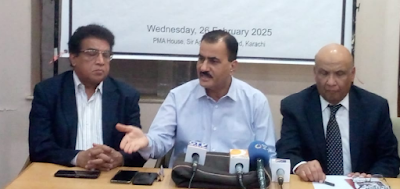Pakistan’s polio fight falters — Part 2: What must change
(In Part 1, we reported on Sindh’s rising virus circulation and the widening immunity gap flagged by national experts. In this concluding part of the special report originally published in Social Track, leading paediatricians and infectious disease experts offer critical insights into why poliovirus continues to circulate in Sindh — and what must change in routine immunisation, accountability, and public health systems to overcome it.)
By Mukhtar Alam
Gaps
in surveillance and campaign efficacy: Prof
Dr Iqbal Ahmed Memon, Chair of the Provincial Expert Review Committee, offered
a nuanced view of Sindh’s polio situation, suggesting that high virus detection
may reflect “better surveillance sensitivity rather than outright programme
failure”.
“The increased detection signals active case finding,”
he said. “However, immunity gaps persist—likely due to vaccine refusals and the
complex dynamics of urban slums.”
He added that such discrepancies are not unique to
Sindh but indicative of broader challenges linked to unregulated migration,
urban congestion, and difficulties in data verification. “The programme is
evolving. The need now is for evidence-based revisions in planning and
implementation,” Dr Memon noted.
Commenting on virus shedding despite OPV
administration, he explained that this actually indicates successful viral
replication and immune response. “But persistent detection suggests incomplete
coverage, low mucosal immunity, or repeated exposure in high-risk areas. While
there’s no immediate mutation threat, prolonged circulation can eventually lead
to vaccine-derived polioviruses (VDPVs),” he cautioned. Hence, he said,
campaigns must remain high in quality and tightly synchronised.
On routine immunisation, he was unequivocal: “High RI
coverage is foundational. Campaign-only protection creates short-term gains—it
cannot sustain eradication goals.”
Touching on sanitation and foodborne transmission, Dr
Memon underscored the need for long-term structural fixes. “Sindh, particularly
Karachi, faces longstanding water and sanitation infrastructure deficits.
Effective mitigation requires inter-sectoral collaboration—targeted
chlorination, hygiene awareness, and WASH partner coordination, especially in
high-density slum areas.”
Independent validation and field checks: Dr Ali Faisal Saleem, a paediatric infectious diseases specialist at the Aga Khan University Hospital, agreed that continued virus detection in environmental samples points to a serious immunity gap.
“This means zero-dose children—either missed or
refused—are still a major issue. Karachi stays persistently positive, and newer
districts are now showing transmission,” he warned.
While the Sindh polio programme reports consistent
campaign performance, Dr Saleem pointed out a possible mismatch: “If both
environmental positives and campaign claims are accurate, there must be a
disconnection between reality and reporting.”
To bridge that gap, he called for a third-party
evaluation of campaign outcomes. “Independent validation, ideally from a
reputable academic institution, should involve lot quality assurance sampling
(LQAS), post-campaign monitoring, and community-based surveys,” he said. “We
must also conduct sero-surveys to measure actual immunity levels—especially in
high-risk districts and those with consistent environmental positives.”
These efforts, he added, should integrate with the government’s zero-dose tracking system to identify and reach unvaccinated children more effectively.
Dr Saleem also clarified that vaccine virus mutation
causing illness in immunocompetent children is “extremely rare.”
“It only happens when vaccination has been absent for
a long time—leaving children with naïve gut and serum immunity. If such
children are exposed to the vaccine virus, it may persist and mutate in their
systems,” he explained.
On routine immunisation, he reinforced the position of
the Global Polio Eradication Initiative (GPEI): “We cannot eliminate polio
without strong RI. At present, coverage in Pakistan—and in Sindh—is below the
critical 80% threshold. This demands immediate, focused intervention.”
A multi-faceted threat: Dr Khalid Shafi, former Secretary General of the Pakistan Paediatrics Association, noted that the troubling data from Sindh underscores significant and ongoing wild poliovirus circulation, both through confirmed cases and environmental samples. “This clearly reflects an immunity gap. While reported missed children are a concern, the real number may be much higher—pointing to both operational shortcomings and broader social factors,” he said.
He stressed that attributing the issue solely to Sindh
would be an oversimplification. “The virus is circulating widely across
Pakistan. Blame must not fall on one province alone. Operational weaknesses,
migratory patterns, anti-vaccine propaganda, and entrenched behavioural
challenges all contribute.”
Dr Shafi highlighted that Pakistan’s Polio Eradication
Initiative is under extensive scrutiny from national leadership, international
agencies, and donors. “The system is monitored from the prime minister down to
deputy commissioners, supported by security agencies and technical oversight by
the WHO’s Technical Advisory Group (TAG), which guides improvements based on
scientific evidence.”
He acknowledged that virus excretion despite OPV is
scientifically expected. “Vaccinated children can shed the virus if community
immunity is inadequate. This doesn’t necessarily mean vaccine failure—it’s
about incomplete herd immunity. Virus evolution is natural, and detection helps
us direct interventions better.”
He also drew attention to India’s experience, which
had over 700 cases the year before eradication. “Detection shouldn’t discourage
us—it should guide targeted action.”
On routine immunisation, Dr Shafi was clear: “Without
high coverage, our efforts will remain incomplete. Routine EPI
vaccinations—OPV, IPV, fractional doses—are vital. Yet Pakistan’s current
coverage remains below target. Polio eradication is just one part; we must aim
to control all vaccine-preventable diseases.”
He also emphasised the critical role of WASH
interventions and strong primary healthcare. “Safe water, sanitation, and a
functioning PHC system are foundational to public health. Unfortunately, we
spend most of our health budget on tertiary care, neglecting these essentials.
Unless we reverse this trend, polio and other preventable diseases will remain
threats.”
“Despite setbacks, Pakistan has made tremendous progress,” Dr Shafi added. “We have the infrastructure, global support, and technical know-how. What’s needed now is honest introspection, stronger accountability, and community trust. With sustained commitment and smarter strategies, polio eradication is not out of reach — we can absolutely get there.”









Comments
Post a Comment